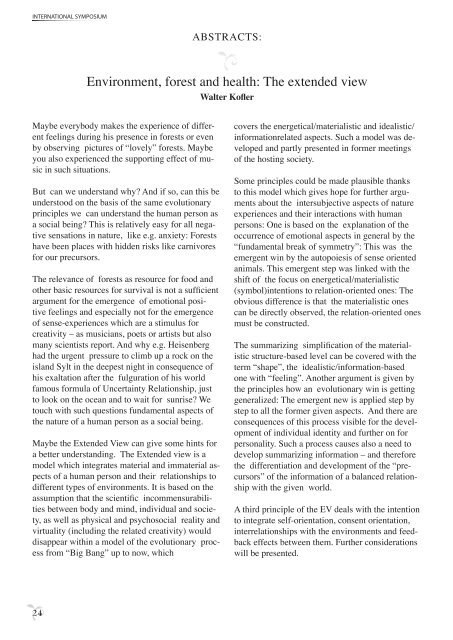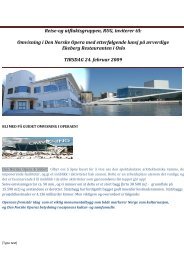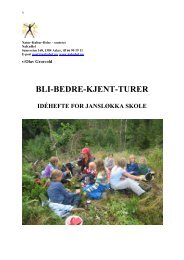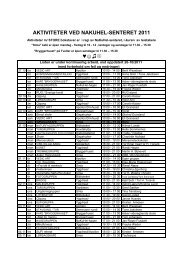Natur og Kultur som Folkehelse - NaKuHel
Natur og Kultur som Folkehelse - NaKuHel
Natur og Kultur som Folkehelse - NaKuHel
You also want an ePaper? Increase the reach of your titles
YUMPU automatically turns print PDFs into web optimized ePapers that Google loves.
INTERNATIONAL SYMPOSIUM<br />
24<br />
ABSTRACTS:<br />
Environment, forest and health: The extended view<br />
Walter Kofler<br />
Maybe everybody makes the experience of different<br />
feelings during his presence in forests or even<br />
by observing pictures of “lovely” forests. Maybe<br />
you also experienced the supporting effect of music<br />
in such situations.<br />
But can we understand why? And if so, can this be<br />
understood on the basis of the same evolutionary<br />
principles we can understand the human person as<br />
a social being? This is relatively easy for all negative<br />
sensations in nature, like e.g. anxiety: Forests<br />
have been places with hidden risks like carnivores<br />
for our precursors.<br />
The relevance of forests as resource for food and<br />
other basic resources for survival is not a sufficient<br />
argument for the emergence of emotional positive<br />
feelings and especially not for the emergence<br />
of sense-experiences which are a stimulus for<br />
creativity – as musicians, poets or artists but also<br />
many scientists report. And why e.g. Heisenberg<br />
had the urgent pressure to climb up a rock on the<br />
island Sylt in the deepest night in consequence of<br />
his exaltation after the fulguration of his world<br />
famous formula of Uncertainty Relationship, just<br />
to look on the ocean and to wait for sunrise? We<br />
touch with such questions fundamental aspects of<br />
the nature of a human person as a social being.<br />
Maybe the Extended View can give <strong>som</strong>e hints for<br />
a better understanding. The Extended view is a<br />
model which integrates material and immaterial aspects<br />
of a human person and their relationships to<br />
different types of environments. It is based on the<br />
assumption that the scientific incommensurabilities<br />
between body and mind, individual and society,<br />
as well as physical and psychosocial reality and<br />
virtuality (including the related creativity) would<br />
disappear within a model of the evolutionary process<br />
from “Big Bang” up to now, which<br />
covers the energetical/materialistic and idealistic/<br />
informationrelated aspects. Such a model was developed<br />
and partly presented in former meetings<br />
of the hosting society.<br />
Some principles could be made plausible thanks<br />
to this model which gives hope for further arguments<br />
about the intersubjective aspects of nature<br />
experiences and their interactions with human<br />
persons: One is based on the explanation of the<br />
occurrence of emotional aspects in general by the<br />
“fundamental break of symmetry”: This was the<br />
emergent win by the autopoiesis of sense oriented<br />
animals. This emergent step was linked with the<br />
shift of the focus on energetical/materialistic<br />
(symbol)intentions to relation-oriented ones: The<br />
obvious difference is that the materialistic ones<br />
can be directly observed, the relation-oriented ones<br />
must be constructed.<br />
The summarizing simplification of the materialistic<br />
structure-based level can be covered with the<br />
term “shape”, the idealistic/information-based<br />
one with “feeling”. Another argument is given by<br />
the principles how an evolutionary win is getting<br />
generalized: The emergent new is applied step by<br />
step to all the former given aspects. And there are<br />
consequences of this process visible for the development<br />
of individual identity and further on for<br />
personality. Such a process causes also a need to<br />
develop summarizing information – and therefore<br />
the differentiation and development of the “precursors”<br />
of the information of a balanced relationship<br />
with the given world.<br />
A third principle of the EV deals with the intention<br />
to integrate self-orientation, consent orientation,<br />
interrelationships with the environments and feedback<br />
effects between them. Further considerations<br />
will be presented.





